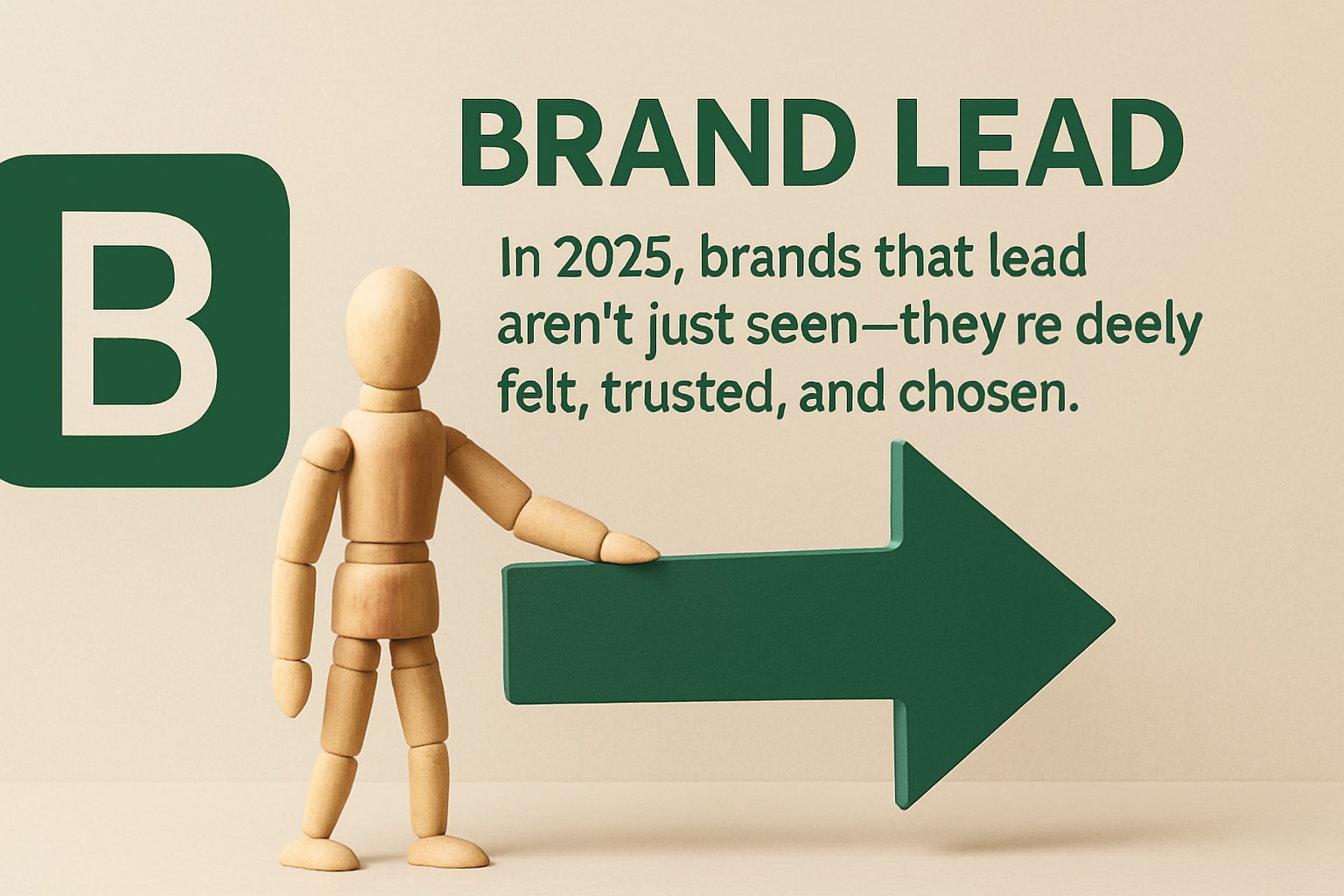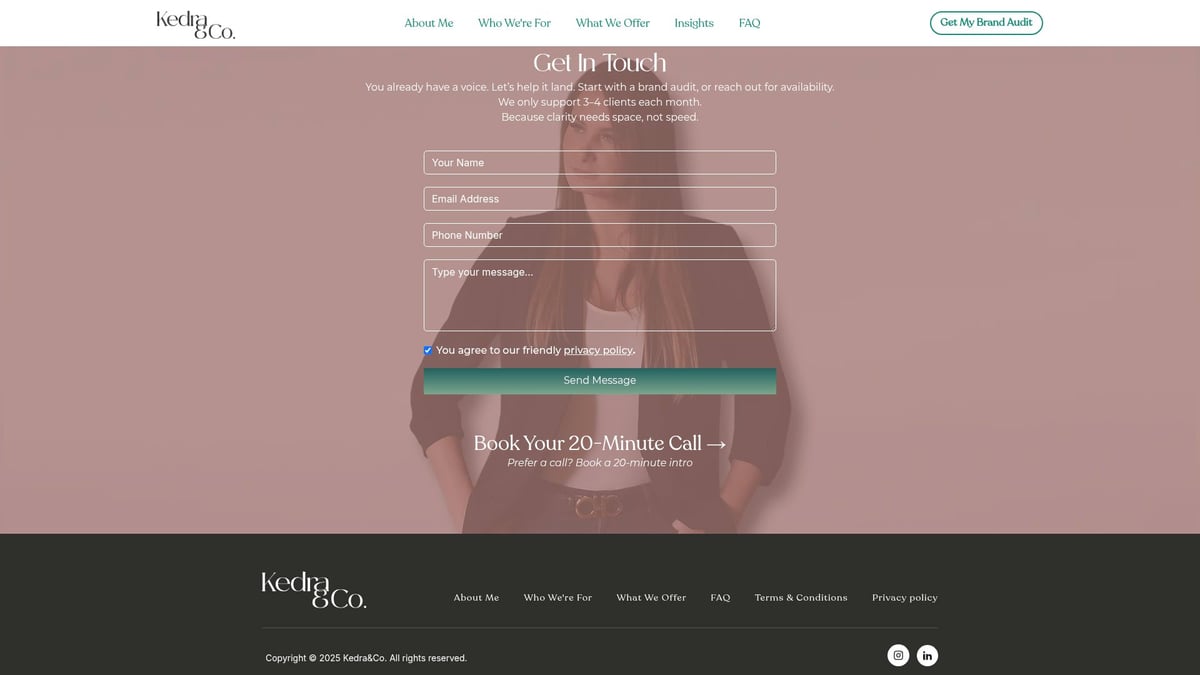
Brand Lead Guide: Strategies for Success in 2025
In 2025, the brands that stand out are more than just visible—they are experienced, trusted, and chosen again and again. The difference is often a clear, empowered brand lead who shapes not only what a company says, but how it is felt both inside and out.
This guide is for founders and teams navigating the evolving landscape of brand leadership. We’ll clarify what a brand lead is, why clarity matters more than content volume, and how inside-out influence drives growth.
You’ll learn how to spot the symptoms of absent leadership, when to invest, and how to build a sustainable brand presence from the core. If you’re ready to lead with intention, you’re in the right place.
What Does It Mean to Be a Brand Lead in 2025?
In 2025, the brand lead is more than a title. It’s a function, mindset, and catalyst for clarity across your business. The role has evolved from simply managing logos or campaigns to becoming a steward of vision, values, and emotional resonance. Today’s brand lead is expected to bridge the gap between internal culture and external perception, guiding teams with empathy and strategic intent.

The Evolving Definition of Brand Leadership
The definition of a brand lead is in flux. No longer is it just a job title or marketing checkbox. It’s a way of thinking, a holistic approach to how a brand lives and breathes inside an organization. While the brand lead once focused on visual identity and campaigns, the 2025 version is a steward of the brand’s whole story.
Founder and expert-led brands have reshaped expectations for what leadership looks like. The brand lead now carries the responsibility of emotional intelligence, weaving narrative and vision into every layer of the business. The rise of AI and personal branding trends, as seen in Personal branding trends for 2025, places even more emphasis on authenticity and empathy. Tech brands leading the way show us that the brand lead is not just protecting the look and feel, but orchestrating a shared sense of purpose.
Brand Lead vs. Brand Manager: Clarifying the Difference
It’s easy to confuse the brand lead with the brand manager, but their focus and impact are distinct. The brand lead is the voice and vision steward, setting direction, shaping the story, and holding space for deeper conversations about identity and trust.
By contrast, the brand manager is the enabler of process and consistency. They operationalize the brand, ensuring guidelines are followed and campaigns run smoothly. In founder-led organizations, both roles may exist, or sometimes the brand lead absorbs elements of management. What matters is clarity—who holds the pen for the brand’s narrative, and who ensures it shows up the same way, every time.
Inside-Out Influence: The New Brand Leadership Model
Today’s brand lead leads from within. Internal clarity and culture build the foundation for how the outside world perceives your brand. The brand lead acts as an internal coach, not just an external spokesperson, equipping teams to live the brand’s values in daily decisions.
When internal values and external messaging align, companies outperform competitors. Workable’s emphasis on team alignment is one example: brands that invest in shared understanding see more authentic customer engagement. The brand lead’s influence radiates from the inside out, shaping not just what you say, but how your people behave and connect.
Brand Leadership as a Growth Lever
Brand leadership is now a true lever for growth. When a brand lead is empowered, the result is sharper differentiation in the market, clearer messaging, and stronger loyalty from both employees and customers.
Recent data shows that brands with robust internal leadership experience higher engagement and trust. The brand lead’s presence is felt in everything from sales conversations to recruiting, making it a strategic advantage, not just a marketing function.
Not Just a Title: Brand Leadership as an Organizational Mindset
The brand lead must be empowered to reach beyond the marketing department. True brand leadership is a cross-functional, executive-level responsibility, touching product, operations, HR, and more.
When leadership is seen as an organizational mindset, not a box to check, the brand lead can drive alignment and momentum. The whole company starts to move with one voice and vision, creating a brand that is not just seen, but deeply felt.
Brand Clarity vs. Brand Content: Why the Difference Matters
In my experience as a brand strategist, I often see founders and marketing leaders chase content volume, hoping it will drive growth. But more blog posts, videos, or social media updates do not guarantee your message will land. The real risk? You end up with noise instead of resonance. A brand lead must recognize that clarity is the compass, not the campaign calendar.

The Pitfalls of Content-First Approaches
When a brand lead prioritizes output over alignment, the results are predictable. Campaigns may flood the market, but few connect. Teams push content out of habit, not conviction. I've seen brands with impressive content calendars, yet their audience feels nothing. The cause? Messaging that lacks a clear foundation.
Typical pitfalls include
- Inconsistent tone between channels
- Campaigns that contradict core values
- High engagement but low long-term loyalty
Without intentional direction from a brand lead, content becomes a race with no finish line.
Brand Clarity: The Foundation for Every Touchpoint
Brand clarity is the anchor for every decision. It is not just a set of guidelines, but a lived system: vision, values, proof points, and a distinct voice. A brand lead ensures these elements are documented and shared across the organization.
Companies that invest in clarity before launching campaigns consistently see higher ROI. As highlighted in Brand marketing starts with clarity, unclear branding fragments campaigns and breeds confusion. A brand lead keeps the story straight from the inside out.
Content as an Extension of Clarity
Content is not the starting point, but the expression of what is already clear inside the organization. A brand lead uses messaging frameworks to guide teams, so every piece of content feels connected but not repetitive.
Consistency is not about sameness, but about trust. A good brand lead allows the voice to adapt to different formats or audiences, while never losing the thread. This approach builds memory, not just impressions.
The Cost of Confusion: Symptoms of Absent Brand Leadership
When the brand lead function is missing or unclear, confusion spreads quickly. Messaging becomes fragmented, with teams speaking in different voices. Customers notice the disconnect, and employees struggle to represent the brand confidently.
Common symptoms include:
- Disconnected campaigns across departments
- Employee uncertainty about what the brand stands for
- Customers asking, "What do you actually do?"
According to recent data, 60 percent of companies cite lack of brand clarity as a barrier to growth. A brand lead can spot and fix these issues before they become costly.
Building a Brand Voice System for Scale
Scaling a brand requires more than a style guide. A brand lead should develop a practical system for documenting voice, tone, and proof points. This system lets new hires ramp up quickly and ensures campaigns stay aligned, even as the company grows.
To start:
- Document key messaging pillars
- Create reference examples for voice
- Train teams on adapting the system to new contexts
Brands with robust voice systems onboard faster and launch campaigns with greater confidence. The brand lead's impact is felt in every touchpoint.
Inside-Out Influence: Leading Brand from the Core
When I talk to founders about brand lead success, I always start at the center—the people, the clarity, the language inside your walls. Influence begins from the core, not the campaign. Leading brand from the inside out is more than a strategy, it is a lived reality that shapes every touchpoint.
The Role of Internal Alignment in Brand Success
A brand lead is not just a storyteller for the outside world. True leadership means bridging the vision at the top with the daily choices of every team member. Internal alignment is the foundation—without it, even the most creative campaigns will ring hollow.
When teams share a common language and purpose, decisions become easier. The brand lead shapes this by connecting executive intent with team execution. I have seen companies thrive when their leadership invests in shared narrative, not just external messaging.
A strong brand lead fosters trust. This trust allows teams to move quickly and consistently, even in uncertainty. Alignment is not a one-time workshop, it is a daily practice.
Coaching, Not Policing: Empowering Teams to Live the Brand
The most effective brand lead acts as a coach, not a police officer. Instead of enforcing rules, they nurture understanding. They create environments where teams feel ownership over the brand and know how to express it in their own roles.
- Facilitate brand-driven decision-making workshops
- Offer training on voice and values in context
- Provide tools and frameworks for consistent execution
Clarity is not about rigidity. It is about enabling creativity within clear boundaries. For practical guidance on building internal alignment, I often point founders to resources like the Communication Guide for Founders. It offers actionable steps to help brand lead roles empower, not control.
Case Study: Founder-Led Brands Succeeding with Inside-Out Leadership
Consider a startup where the founder’s personal journey is woven into every onboarding and team meeting. The brand lead in this context amplifies the founder’s story, making it accessible and relevant to every department.
Internal storytelling becomes a differentiator. When employees can see themselves in the brand’s mission, they advocate for it naturally—both inside and out. The result is a durable trust that shows up in customer interactions, recruitment, and even product decisions.
I have watched founder-led brands outperform competitors because their inside-out approach is felt by everyone who touches the business.
Measuring Internal Brand Health
How do you know if your inside-out strategy is working? A data-driven brand lead relies on clear metrics:
- Employee engagement scores
- Net Promoter Score (NPS) for both staff and customers
- Brand advocacy rates across teams
Regular brand audits and open feedback sessions make it possible to surface gaps before they become costly. Measurement is not about policing—it is about nurturing a healthy, resilient brand from within.
Overcoming Resistance and Silos
Even the most aligned organizations encounter friction. Silos can form as teams scale or priorities shift. A brand lead must be proactive in breaking down barriers. This means:
Change does not happen overnight. It requires patience, listening, and a willingness to revisit assumptions. The best brand lead never stops learning from their team.
How Kedra&Co. Supports Inside-Out Brand Leadership
At Kedra&Co., we partner with founders at critical moments—launches, pivots, rebrands—to clarify brand voice and build leadership systems from the inside out. Our approach blends psychology, business strategy, and operational frameworks so your brand lead can drive confident, consistent presence.

We help brands align internal culture with external promise, ensuring every team member becomes an advocate for your brand. Whether you need a partner, a roadmap, or both, we’re here to lead with you.
Recognizing the Symptoms of Absent Brand Leadership
Spotting the early signs of a missing brand lead can mean the difference between steady growth and a slow unraveling. As someone who has guided founders and marketing leads through these waters, I see the same patterns repeat when brand lead presence is lacking.

Warning Signs in Founder-Led and Scaling Brands
The absence of a clear brand lead often shows up first in subtle ways. Messaging drifts across teams and platforms. One team might describe your company as bold and disruptive, while another calls it dependable and safe. Leaders struggle to articulate not just what you do, but why it matters.
During rapid growth, this misalignment compounds. If a founder steps back or new executives join, the original vision can easily get diluted. I’ve seen scaling brands lose their way simply because no one owns the brand lead lens.
- Inconsistent messaging across channels
- Leadership unable to express core values
- Brand identity shifts during transitions
Impact on Employee Experience and Customer Trust
A missing brand lead does more than confuse your market—it erodes your team’s purpose. When employees hear one thing from leadership and another in the market, morale drops. Teams become misaligned, and turnover can rise as clarity fades.
Customers pick up on this, too. They sense when your story lacks conviction or when promises feel hollow. According to Workable, 70% of employees say unclear brand direction directly impacts their job satisfaction. The ripple effect? Customers lose trust, and your market position weakens.
A strong brand lead helps prevent these fractures by anchoring both internal culture and external reputation.
Brand Drift: Causes and Consequences
Brand drift happens when there is no brand lead guiding the narrative. Without a documented voice system or narrative framework, teams create their own versions of the story. Over-reliance on agencies, without internal stewardship, can make things worse.
- Lack of unified voice or messaging system
- Fragmented campaigns that don’t build equity
- Missed chances for differentiation
The financial consequences are real. As highlighted in the Financial impact of brand clarity, brands with clear messaging see up to 23% higher revenue and reduced operational costs. When the brand lead role is missing, these gains are left on the table.
Diagnosing and Addressing Brand Gaps
When symptoms appear, it’s time for a brand audit. I recommend starting with honest feedback sessions across teams. Where do stories diverge? Who feels clear, and who doesn’t?
Involving cross-functional teams in this process is vital. Marketing alone cannot fix what is ultimately a leadership issue. Invite product, sales, and operations into the conversation. A true brand lead brings everyone to the table, not just the usual suspects.
When to Intervene: The Cost of Waiting
Early intervention is always less painful than a reactive rebrand. If you sense the warning signs, act before crisis hits. Brands that invest in leadership ahead of inflection points outperform those who wait for things to break.
I’ve seen companies that prioritized a brand lead role before major transitions keep their teams aligned and their customers loyal. Waiting too long can mean lost revenue, missed opportunities, and a longer road to recovery.
When and How to Invest in Brand Leadership
Recognizing when to invest in brand leadership is more than a tactical decision. It is a reflection of your company’s readiness to move from reactive to intentional brand building. In my experience, the right investment at the right time can transform not just your marketing, but your culture and growth trajectory.
Inflection Points: When Brand Leadership Is Critical
Every company faces moments where the stakes rise. These inflection points are when the absence or presence of a brand lead can make or break momentum. Launches, pivots, mergers, and hypergrowth all demand clarity and unity.
Consider the founder who is preparing for a new market or an executive transition. This is precisely when investing in a brand lead becomes essential. A dedicated brand lead ensures the vision holds steady and the voice remains clear, even as the business shifts. For a detailed look at these moments, see Launching a New Brand Successfully.
If you are pre-IPO or seeking investor confidence, a brand lead is your anchor. They turn inflection points into launches, not landmines.
Hiring vs. Developing Brand Leadership Internally
Should you hire a brand lead externally or cultivate one from within? Both paths have merit, but the answer often comes down to your culture and stage.
An internal candidate knows your story, but may need support to grow into the brand lead role. External hires bring proven frameworks and objectivity. Look for emotional intelligence, narrative skill, and the ability to unify teams.
Building a Brand Leadership Function: Step-by-Step
A brand lead needs more than a job description. Here is how I guide founders through the process:
- Audit your current brand clarity and leadership gaps.
- Define outcomes and the scope of brand lead influence.
- Build a roadmap and document your brand voice system.
- Secure executive alignment and allocate resources.
- Roll out training and feedback loops across teams.
A typical rollout spans six months, with key milestones for alignment, documentation, and adoption. The brand lead should be at the center, not the sidelines.
Partnering with External Experts for Brand Leadership
Sometimes, the fastest way to clarity is to bring in outside perspective. External experts can help a brand lead accelerate alignment, especially during transitions or rapid growth.
Partnering with consultants or agencies works best when you need to challenge assumptions or operationalize new systems. The brand lead benefits from frameworks, coaching, and fresh eyes, while your team gains confidence in the process.
Choose partners who listen first, then guide. The goal is to empower your internal brand lead, not replace them.
Budgeting and ROI: Making the Business Case
Investment in a brand lead is not just a marketing expense. It is a lever for employee engagement, customer trust, and long-term equity.
Typical spend ranges from senior hire salaries to consulting retainers for specialized support. Data shows that brands with dedicated leadership functions report 23% higher brand equity. For founders balancing brand investment and performance, see Balancing Brand Building and Performance.
A brand lead pays for themselves in reduced churn, faster onboarding, and a voice that resonates in every market.
Sustaining Brand Leadership in a Changing Market
The market never stops moving, and neither can your brand lead. Ongoing measurement and adaptation are essential.
- Track internal engagement and brand health.
- Update your brand voice system as needed.
- Build succession plans so the brand lead function endures through change.
A brand lead who learns, adapts, and leads cross-functionally is your best hedge against uncertainty.
Brand Lead Success Strategies for 2025 and Beyond
Stepping into the brand lead role in 2025 means more than managing a logo or campaign. It’s about showing up as a guide, a connector, and an advocate for clarity across your company. The strongest brand lead isn’t just seen—they’re trusted because they lead from within, not just from a title.
The Emotional Intelligence Advantage
The most impactful brand lead in 2025 listens before they speak. Empathy, curiosity, and the ability to read the room are now as critical as creative instincts. In my experience, the difference between a brand that’s followed and a brand that’s felt often comes down to emotional intelligence.
When a brand lead can weave empathy into their messaging, teams feel seen and customers feel understood. This is especially true for founder-led brands, where the line between personal narrative and brand story can get blurry. If you want to see the power of this dynamic, consider how Founder's Role in Brand Storytelling shapes trust and loyalty from the inside out.
Voice Systems: Scaling Consistency Without Stifling Creativity
A brand lead knows that scaling doesn’t mean sameness. Instead, they build frameworks—a brand voice system, documented values, and clear proof points—that guide every touchpoint. These systems empower teams to create, adapt, and innovate, all while staying true to the core.
- Document your brand’s tone, language, and narrative tools
- Enable teams with templates and reference materials
- Encourage feedback to keep the voice system alive
When your voice system is operationalized, onboarding is faster and campaign alignment comes naturally. The brand lead’s job is to balance consistency with enough flexibility for new ideas.
Cross-Functional Collaboration as a Brand Lead
Brand does not live in marketing alone. A successful brand lead bridges the gap between marketing, product, sales, and leadership. Workshops, alignment sessions, and shared language are the tools of the trade.
What sets a great brand lead apart is their ability to listen for disconnects, surface hidden strengths, and bring teams together around a single story. When every department understands the “why” behind the brand, decisions become more unified and momentum builds.
Navigating AI and Automation in Brand Leadership
AI is quickly becoming part of the brand lead toolkit, offering insights into sentiment, consistency, and market trends. But technology should never replace the human touch. The real art is knowing when to leverage automation and when to lean into intuition.
For instance, automation can spot off-brand messaging or track how your story lands across channels. Still, it’s the brand lead who interprets what matters most. To stay ahead, keep an eye on Leadership trends to watch in 2025 and use new tools to support—not replace—your leadership.
The Brand Lead as Change Agent
Change is constant—whether it’s a pivot, a crisis, or rapid growth. The brand lead steps in as a steady hand, guiding teams through uncertainty with clarity and resilience.
This means being proactive about tough conversations, surfacing emerging risks, and championing the brand’s core values even when the path forward is unclear. The best brand lead is adaptable, not reactive. They prepare the ground for transformation before it’s forced upon them.
Future-Proofing Brand Leadership
Learning never stops for a brand lead. Markets shift, trends come and go, and consumer trust evolves. The strongest leaders invest in continuous growth—reading, listening, and challenging their own assumptions.
Future-proofing is about building a culture where curiosity is valued and new perspectives are welcomed. A brand lead who stays open and alert will spot opportunities before they become urgent needs.
Kedra&Co helps founders clarify their brand voice, then shape the leadership it needs. Whether you need a partner, a roadmap, or both, we’re here to lead with you.
You’ve seen how real brand leadership isn’t just about what you say—it’s about how you show up and what people feel when they cross paths with your company. If you’re ready to move past surface-level content and step into clarity, I’m here to help you lead from the inside out, not just keep up appearances. Your lived experience and vision deserve to be heard in a way that feels true. If you’re looking for a partner to help you bring that voice forward, let’s take the next step together.
Let’s shape a brand that sounds like you


